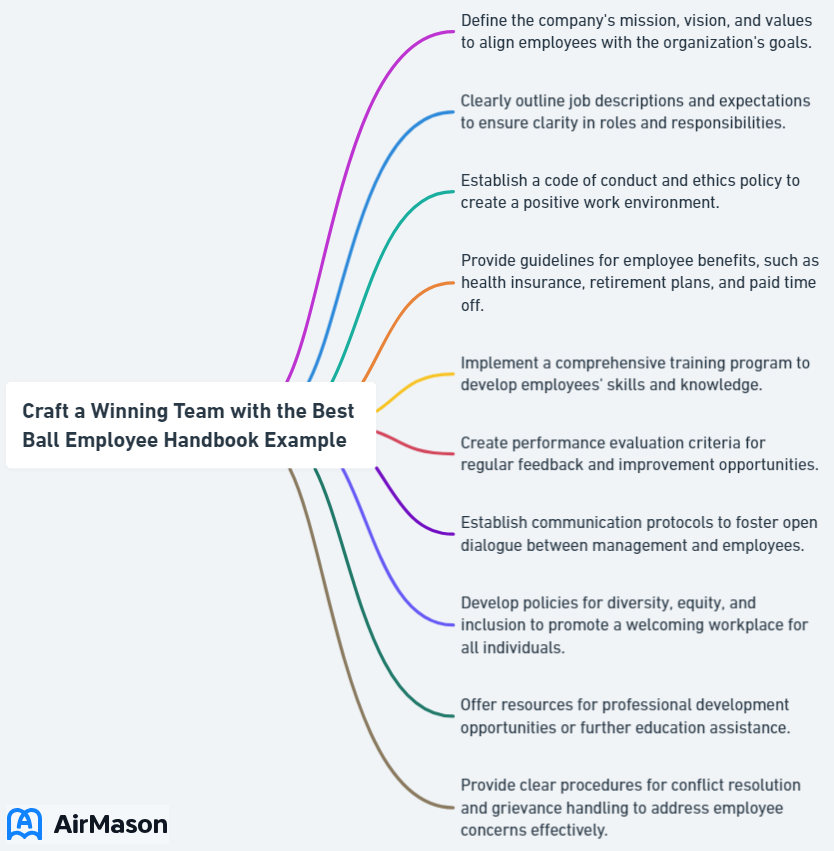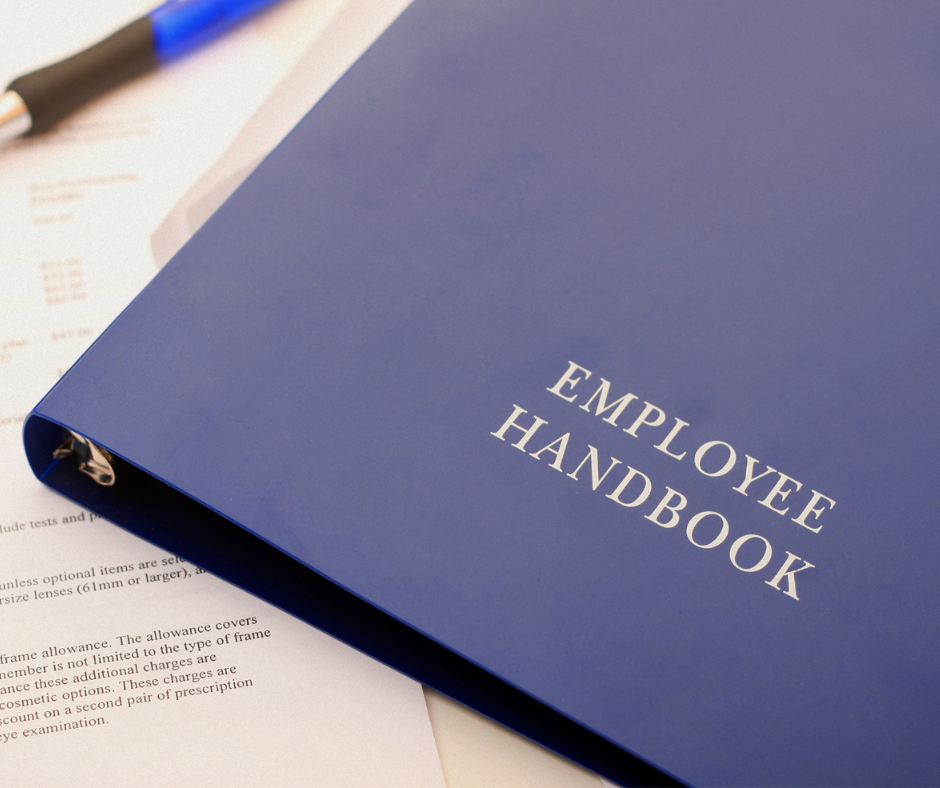
Are you looking to craft an employee handbook that not only informs but engages your team? A winning employee handbook sets the tone for your organization, establishes expectations, and fosters a connection between employees and your company’s mission. In this blog post, you’ll discover a ball employee handbook example and learn how to create your own compelling handbook that covers everything from company culture to legal considerations.
Key Takeaways
- Create an engaging and comprehensive employee handbook that reflects company culture, values, and provides clarity.
- Include key components such as mission/vision statements, benefits/perks, code of conduct & workplace policies.
- Ensure readability with Flesch-Kincaid scale, implement digital accessibility guidelines for all employees, review annually to keep compliant with laws & regulations.
Fortune 100 Company Employee Handbook
Welcome to the comprehensive guide that is the Fortune 100 Company Employee Handbook. Here, you will find essential information about our organization’s policies, procedures, and expectations. The Fortune 100 Company Employee Handbook serves as your go-to resource for understanding our commitment to fostering a positive and inclusive work environment. As you navigate through these pages, you’ll gain insights into our core values, code of conduct, and the myriad opportunities for professional growth. This handbook is designed to empower you with the knowledge needed to thrive within our esteemed Fortune 100 company. Take the time to familiarize yourself with its contents, as it is an invaluable tool for your success and integration into our dynamic workplace culture.
The Ball Employee Handbook: A Model Example
The Ball Employee Handbook is a shining example of a comprehensive and engaging guide for employees. This handbook excels in providing clarity, emphasizing company culture, and showcasing visual appeal. The Ball Employee Handbook, with its focus on these aspects, provides both new hires and existing employees a comprehensive understanding of company policies, workplace safety procedures, and the company’s mission.
Taking inspiration from successful employee handbooks like Ball’s, you can craft an effective employee manual that not only communicates crucial information but also demonstrates the unique culture and values of your organization. With an engaging and accessible handbook, you’ll foster employee engagement and provide a solid foundation for your team.
Clarity and Conciseness
Clarity and conciseness are essential in an employee handbook, ensuring that employees can easily understand and follow the guidelines and expectations set forth. Creating a handbook that uses simple language, avoids jargon, and provides illustrative examples makes it both informative and digestible. This in turn guarantees that employees can readily comprehend and adhere to the regulations and expectations established.
One noteworthy example showcasing clarity and conciseness is the Valve employee handbook. It is renowned for its well-crafted composition and enjoyable readability, often using bullet points to present information in a clear and concise manner. Incorporating these principles into your own handbook makes it an easy-to-understand and follow resource for your employees.

Company Culture and Values
An employee handbook that emphasizes company culture and company values can create a strong sense of connection between employees and the organization. A clear definition of your company’s mission and vision conveys the purpose and goals of your business, fostering alignment between employees and the organization’s objectives.
Incorporating interactive scenarios into your handbook can further communicate company culture and values, and even provide employees with opportunities to hone their communication skills. Showcasing your company culture in the handbook strengthens employees’ connection to the organization and enhances their understanding of its mission and objectives.
Visual Appeal

A visually appealing employee handbook can be more enjoyable to read and help employees retain the information presented. By incorporating visual elements such as infographics, icons, and images, you can create an engaging and aesthetically pleasing guide for your team.
For example, the Hubspot employee handbook is renowned for its traditional PowerPoint format, utilization of images and colors, and conversational yet playful tone. This visually appealing design includes guidelines on workplace safety and other important policies, making it easy for employees to comprehend and follow. A focus on visual appeal can result in an employee handbook that both informs and engages.
Crafting Your Own Employee Handbook: Key Components
When creating your own employee handbook, there are key components that you should include to ensure a comprehensive and engaging guide for your employees. These components are the company mission and vision, employee benefits and perks, and code of conduct and workplace policies. Including these elements aids in creating a comprehensive handbook that serves as an invaluable resource for your team.
With a solid foundation of these key components, your employee handbook can serve as a roadmap for your employees, guiding them through company policies, expectations, and benefits. This not only helps new hires get up to speed quickly but also serves as a valuable reference for existing employees.
Company Mission and Vision
A clear and concise mission statement and vision statement are the cornerstones of a successful employee handbook. These statements set the tone for the rest of the handbook and help employees understand the organization’s purpose and goals.
To effectively include your company’s mission and vision in your handbook, establish clear statements that reflect your organization’s values and aspirations. Ensure that these statements are prominently featured in your handbook and educate employees on their significance.
Aligning the goals and tasks outlined in the handbook with your company’s mission ensures a cohesive and purpose-driven guide for your team, reflecting the company’s mission and vision.
Asbury Automotive Group Employee Handbook Example
In this illustrative Asbury Automotive Group Employee Handbook Example, employees gain valuable insights into the company’s guiding principles and expectations. The Asbury Automotive Group Employee Handbook exemplifies a comprehensive approach to fostering a positive work environment. Covering a range of topics, from company policies to employee benefits, this handbook serves as a crucial resource for all team members. By adhering to the guidelines outlined in the Asbury Automotive Group Employee Handbook Example, employees contribute to a workplace culture that values professionalism, teamwork, and mutual respect. As a reference document, this handbook plays a pivotal role in aligning employees with the organization’s mission and ensuring a harmonious and productive work environment.
Employee Benefits and Perks

Outlining employee benefits and perks in your handbook is vital for attracting and retaining top talent. By providing a comprehensive overview of both standard benefits, such as medical coverage and paid time off, and unique perks specific to your company, you can demonstrate your commitment to employee well-being and satisfaction.
To effectively include employee benefits and perks in your handbook, be clear and thorough in your descriptions. Make sure to cover all aspects of your benefits package, including eligibility requirements, enrollment procedures, and any limitations or exclusions. Doing so gives employees a clear understanding of the advantages of working for your organization.
Code of Conduct and Workplace Policies
Establishing a code of conduct and workplace policies is crucial for creating a safe, respectful, and productive work environment. A well-defined code of conduct provides guidance to employees regarding appropriate behavior while at work, including policies on:
- language
- dress code
- device usage
- drug and alcohol policy
- conflict resolution
- social media use
In your employee handbook, be sure to clearly outline the expected behavior and actions of your employees. Provide examples of acceptable and unacceptable conduct, and explain the consequences of violating these guidelines. Having a clear code of conduct and workplace policies in place ensures that all employees are aware of their expectations, contributing to a positive work environment.
Essential Legal Considerations
Legal considerations are an important aspect of creating a comprehensive employee handbook. By addressing the following policies and agreements, you can protect your company and create a safe and inclusive workplace:
- Anti-discrimination and harassment policies
- Confidentiality agreements
- Non-compete agreements
- Compliance with labor laws
Incorporating these legal considerations in your employee handbook not only safeguards your organization from potential legal issues but also demonstrates your commitment to creating a fair and equitable work environment. Staying up-to-date with relevant laws and regulations helps maintain the compliance of your handbook and its value as a resource for your employees.
Anti-Discrimination and Harassment Policies
Implementing anti-discrimination and harassment policies in your employee handbook is essential for protecting your employees and fostering a safe and inclusive work environment. By clearly defining what constitutes discrimination and harassment and outlining reporting procedures for employees to follow, you can create a supportive and respectful workplace.
In your handbook, provide clear and concise guidelines on the consequences for violating these policies and procedures, including your social media policy, leaving no room for misinterpretation. Doing so demonstrates your commitment to promoting diversity, equity, and inclusion within your organization, creating a workplace where all employees feel valued and respected.
Confidentiality and Non-Compete Agreements
Confidentiality and non-compete agreements are vital for protecting your company’s intellectual property and preventing conflicts of interest. By including these agreements in your employee handbook, you can safeguard your company’s trade secrets and ensure that employees are aware of the expectations placed upon them.
To effectively include confidentiality and non-compete agreements in your handbook, follow these steps:
- Define the scope, duration, and geographical limitation of these agreements.
- Explain the rationale behind these agreements.
- Consult with a lawyer to ensure that these agreements adhere to relevant laws and regulations.
- Provide clear consequences for any violations.
Compliance with Labor Laws
Ensuring that your employee handbook complies with all applicable labor laws is crucial for avoiding potential legal issues. By including provisions for:
- minimum wage
- overtime pay
- recordkeeping
- youth employment standards
By informing employees about their rights and entitlements, such as sick leave, you can demonstrate your dedication to adhering to labor laws and ensure that employees are aware of their rights and entitlements.
In your handbook, provide clear and concise information on relevant labor laws and how your company complies with them. Staying current with changes in legislation and updating your handbook accordingly helps maintain a legally compliant and informative resource for your employees.
Making Your Employee Handbook Engaging and Accessible
Creating an engaging and accessible employee handbook is essential for fostering employee engagement and providing a valuable resource for your team. In the process of creating an employee handbook, focusing on readability, design and layout, and digital accessibility results in a handbook that is not only informative but also enjoyable to read.
An engaging and accessible handbook can significantly enhance the onboarding experience and overall employee engagement within your company. By implementing best practices in readability, design, and digital accessibility, you can craft a handbook that effectively communicates crucial information and demonstrates your company’s unique culture and values.
Readability
Ensuring that your employee handbook is easy to read is essential for effective communication. By using clear language, concise sentences, and engaging writing, you create a handbook that is both informative and digestible. Aim for a reading level of around 7th or 8th grade, as this can guarantee that employees can comprehend the material effortlessly.
To gauge the readability of your handbook, consider using the Flesch-Kincaid scale, which provides a score ranging from 0-100 that indicates the “reading ease” of the text. Focusing on readability results in an employee handbook that is easy to understand and follow, keeping your employees well-informed and engaged.
Design and Layout

Creating an appealing design and layout for your employee handbook can make it more enjoyable to read and help employees retain the information presented. Incorporate visuals and graphics, such as infographics, icons, and images, to create an engaging and aesthetically pleasing guide for your team.
For example, consider the well-designed employee handbook by Hubspot, which uses a PowerPoint format, images, and colors to create an engaging and visually appealing resource. Focusing on design and layout results in an employee handbook that not only informs but also engages your employees.
Digital Accessibility
Making your employee handbook digitally accessible allows employees to easily access and reference it as needed. By converting your handbook into a digital format, such as a PDF or an online platform, you can make it more accessible and efficient, particularly for remote employees.
To make your employee handbook digitally accessible, adhere to accessibility guidelines, such as the Americans with Disabilities Act (ADA). Here are some best practices to follow:
- Use clear language to ensure that the content is easily understood by all employees.
- Properly format the handbook with headings and subheadings to make it easy to navigate.
- Provide alternative text for images to ensure that visually impaired employees can understand the content.
Implementing these best practices results in a digitally accessible employee handbook that is convenient and inclusive for all employees.
Implementing and Updating Your Employee Handbook
Once you have crafted your employee handbook, it is important to implement and update it to ensure it remains relevant and useful for your team. This involves introducing the handbook during employee onboarding, conducting periodic reviews, and continuously improving the content based on feedback from employees.
Focusing on these aspects helps create an employee handbook that:
- Communicates important information
- Evolves with your company and its needs
- Ensures that your handbook remains an invaluable resource for your team
- Fosters employee engagement
- Provides a strong foundation for your organization.
Employee Onboarding

Introducing your employee handbook during the onboarding process is crucial for setting expectations and establishing a strong foundation for new hires. By providing new employees with essential information regarding:
- the company’s mission
- values
- culture
- regulations
By ensuring a smooth onboarding process, you can facilitate a seamless transition into their new role and help them make the most of their vacation time.
To effectively present the handbook to new hires, follow this step by step guide:
- Start with a warm welcome and emphasize the importance of the handbook as a guide for their employment.
- Offer immediate support and answer any queries they may have about the handbook.
- Ensure that your new employees have a thorough understanding of their roles and responsibilities within your organization.
Periodic Reviews
Conducting periodic reviews of your employee handbook is essential to ensure it remains up-to-date and relevant as your company evolves. By reviewing the content on an annual basis, you can identify any outdated information, particularly regarding legal and regulatory changes, and make necessary adjustments to keep your handbook current.
Involving HR experts or employment lawyers in the review process can help ensure that your handbook remains compliant with applicable laws and regulations. Conducting periodic reviews helps maintain a valuable and informative resource for your employees, fostering engagement and a positive work environment.
Continuous Improvement
Continuously improving your employee handbook is vital for fostering a successful team and productive work environment. By gathering input from employees and implementing necessary changes, you can ensure that your handbook is current and meets the needs of your team.
Utilize surveys and feedback sessions to gain insight into employee needs and concerns, and make adjustments to the handbook accordingly. Focusing on continuous improvement helps create a valuable resource for your employees that evolves with your company and its needs.
Summary
In conclusion, crafting a winning employee handbook involves focusing on clarity, company culture, visual appeal, key components, legal considerations, and accessibility. By implementing these principles and continuously updating your handbook based on employee feedback, you can create an invaluable resource that not only informs but also engages your team. With a well-crafted employee handbook, you can foster employee engagement and provide a solid foundation for your organization’s success.
Frequently Asked Questions
What is the purpose of an employee handbook?
An employee handbook serves as a comprehensive guide for employees, providing them with the necessary information to understand their role in the organization and outlining the company’s mission, policies, processes, and SOPs.
How can I make my employee handbook engaging and accessible?
Make your employee handbook engaging and accessible by emphasizing readability, design, layout, and digital accessibility.
What are the key components that should be included in an employee handbook?
Include the company mission and vision, employee benefits and perks, and code of conduct and workplace policies to ensure employees understand their role and expectations.
How often should an employee handbook be reviewed?
Employee handbooks should be reviewed annually to ensure that policies and procedures are up-to-date.
How can I ensure that my employee handbook complies with labor laws?
Ensure your employee handbook is up to date with current labor laws by providing clear and concise information on relevant legislation and how your company complies with it.
Important Disclaimer:
The article presented here does not serve as a representation of the company’s actual employee handbook mentioned in this article.
Our discussions and insights regarding employee handbook are based on assumptions about what may be considered significant in the companies’ policies. These assumptions are drawn from available information and industry knowledge. Readers are advised that the content provided is for informational purposes only and should not be construed as an exact reflection of any company’s official policies or procedures. For precise and accurate details regarding a company’s employee handbook, individuals should refer directly to the company’s official documentation or consult with appropriate representatives.
Please be aware that the content on this page has been generated by using artificial intelligence language models and may contain errors, inconsistencies, or outdated information. It is provided as-is without any warranties or guarantees of accuracy. We strongly recommend using this content as a starting point for further research. We disclaim any liability for damages or losses resulting from the use or reliance on this content.